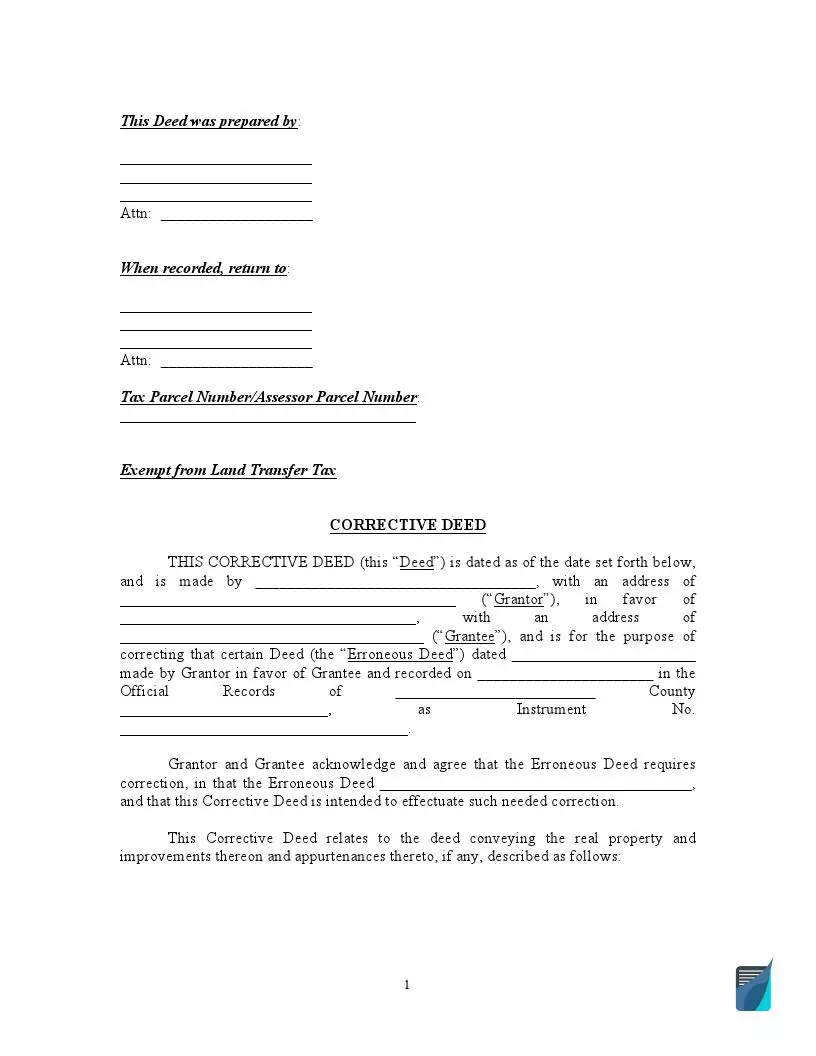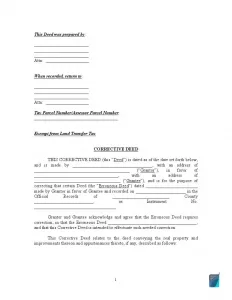Correction Deed Form
Although all deeds to real property are double-checked before notarization and recording, some mistakes can still go unnoticed. Whatever the reasons behind those errors might be, they must be fixed to avoid further problems with the title. One of the legal instruments provided for turning the wrong into the right is a correction deed, also known as corrective, confirmatory, or confirmation deed across various states. A corrective deed form allows removing some flaws from the documents without going to court or filing them all over again.

Build Your Document
Answer a few simple questions to make your document in minutes
Save and Print
Save progress and finish on any device, download and print anytime
Sign and Use
Your valid, lawyer-approved document is ready
What Is a Correction Deed?
The document in question is a legal corrective instrument recognized in many states, which serves to cure erroneous deeds following their recording with a local government office. Its main distinction is that it does not transfer any property rights anew and creates no new interest but introduces corrections into an existing document, retaining all its basic provisions. The very name of the confirmatory deed implies that it confirms the conveyance and covenants of the initial document, so it fully duplicates the content except for corrected information.
When Is a Correction Deed Used?
Basically, there are two legal instruments introduced to change some information in a deed without litigation and execution of a new document. The first one is a scrivener’s affidavit, which is applied to fix minor errors revealed after a deed is recorded. As the name suggests, it is filed by the drafter of the initial document and mainly covers typos and other obvious mistakes such as misspelled names, missed execution dates, or inaccuracies in the legal description of the property. However, an affidavit of correction does not cure the document itself, as it is used only to notify about the errors detected and accurate information that should replace the erroneous one. So, the affidavit works more like an addendum to the initial deed without confirming its content and ensuring that the added information will prevent troubles with further instruments. To put it shortly, it is just a statement of the person who prepared the original document, which statement is based on the knowledge the person has.
In contrast, a correction deed provides much more certainty as to curing the defects of a deed since it repeats the provisions of the initial document, thus confirming all of the basic warranties and retaining the legal substance. It is also signed by all the initial parties to the deed and acknowledged by a notary public, while the affidavit only requires its drafter to notify the parties about the changes introduced, which is illustrated through the example of the North Carolina correction procedure and the Texas Property Code. And though a confirmatory deed is often used to fix the same problems as the previous instrument does, it actually removes nonmaterial defects and even is applicable to material corrections in some states.
However, the requirements differ across states, and some of them do not provide any corrective instruments when it comes to material errors that can affect the legal substance of a deed. This usually covers adding or removing grantees, changing the price of the property, or altering the property’s legal description, which might require the execution of a new deed rather than using an affidavit or corrective deed form.
How to Use a Correction Deed
Obviously, it is necessary to follow local statutory requirements that explain how to correct an error in a deed for the document to be legally valid. Besides major requirements concerning the content and format of the instrument, there might be other regulations to comply with, i.e., margins, paper quality, and so on. Along with that, executing the document includes several common steps described below.
Defining the mistake
First of all, you need to define whether the error found is curable through a confirmatory deed by referring to the local regulations. Also, you have to check the accuracy of the information that will replace the erroneous one.
Making the correction
Take the text of the original deed and introduce the correction needed without changing other provisions of the document.
Adding the explanation
The explanation must clarify why the correction is made and specify not only the wrongful and accurate information but also the title of the original document and where it was recorded so that the correction deed contains a clear reference to the previously recorded document. This paragraph can be added to any part of the document body.
Changing the cover page
The new cover page must include wording identifying the document as a corrective instrument, for example, “Correction Special Warranty Deed.”
Getting signatures
The prepared document must be signed by the original parties (and, sometimes, witnesses) and notarized prior to being recorded with the county clerk.
What a Correction Deed Should Include
As it was mentioned before, requirements for corrective instruments and even the set of instruments available vary from state to state. However, certain pieces of information are both universal and mandatory when constructing a confirmatory deed:
- grantor’s and grantee’s full names and mailing addresses
- property’s legal description
- amount of consideration
- reference to the original title
- correction statement
- description of the changes made
- explanation of the changes
- preparation statement
- execution date
- signatures of the parties and witnesses, if any
- acknowledgment
- return mail address

Filling Out a Correction Deed Form
It is a smart idea to leverage a corrective deed form adopted in your state or county for faster and more accurate document execution. With this form at hand, the whole process will boil down to several simple steps.
Get the form
Search for a valid corrective deed form in your state/county library or download it from this resource. Also, you need to have the original deed or its copy for reference.
Transfer the initial information
Fill in the form with the above mentioned details derived from the previous document.
Introduce the corrections
Insert an error explanation citing both wrongful and true information.
Get the signatures
All the blank spaces for signatures must be filled out, and the signatures must be notarized.
Frequently Asked Questions
How a correction deed should be signed?
Most typically, the document is signed by both the original grantor and grantee. However, some counties mention only the grantor’s signature as a mandatory part of the deed. The same inconsistency is observed as to witnesses, so you will need to check out your clerk’s website and clear up local requirements. Anyway, the signatures must be acknowledged by a notary public for the document to become valid.
What is the difference between a correction deed and an affidavit of correction (scrivener’s affidavit)?
The affidavit is not designed to cure an original deed since it is just a notification about inaccuracies found in the document. In its turn, a correction deed serves as a curative instrument since it actually replaces the previous deed while retaining its legal substance. To this end, it contains all the main provisions of the initial document except for defects and is signed by the original parties.